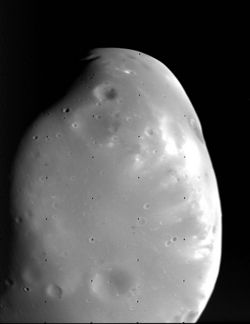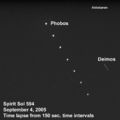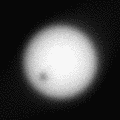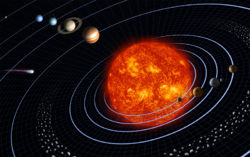Deimos
 From Conservapedia
From Conservapedia | Deimos | |
|---|---|
 Deimos by Viking Orbiter | |
| Date of discovery | August 12, 1877 |
| Name of discoverer | Asaph Hall |
| Name origin | Greek deimos panic; attendant of Greek god of war |
| Orbital characteristics | |
| Primary | Mars |
| Order from primary | 2 |
| Periareion | 23,455 km[1] |
| Apareion | 23,465 km[1] |
| Semi-major axis | 23,460 km[2] |
| Orbital eccentricity | 0.0002[2] |
| Sidereal month | 1.262 da[2][3] |
| Avg. orbital speed | 1,36 km/s[4] |
| Inclination | 1.8°[2][4] to the ecliptic |
| Rotational characteristics | |
| Sidereal day | 1.026 da[3] |
| Rotational speed | 1.35 km/h |
| Axial tilt | 0° |
| Physical characteristics | |
| Mass | 1.4 * 1015 kg (2.5 * 10-8% earth)[1] |
| Density | 1,471 kg/m³[5] |
| Mean radius | 6.2 km[5] |
| Surface gravity | 2.5 * 10-3 m/s² (2.6 * 10-4 g)[1] |
| Escape speed | 0.0056 km/s[1] |
| Surface area | 480 km²[1] |
| Mean temperature | 233 K |
| Composition | Rock and ice mix |
| Albedo | 0.068[5] |
Deimos (from the Greek δειμος or deimos panic) is the outer, and the smaller, of the two satellites of Mars.
Contents
- 1 Discovery
- 2 Orbital and physical characteristics
- 3 Origin
- 4 Exploration
- 5 Gallery
- 6 References
Discovery[edit]
Deimos was discovered by the astronomer Asaph Hall on August 12, 1877, at the United States Naval Observatory in Washington, DC.[6][7][8] The astronomer V. Knorre named the satellite Deimos (and also provided the name Phobos for the other satellite that Hall discovered six days later), per a suggestion by Henry G. Madan of Eton, based on the names given in The Iliad for the two servants of Ares, the Greek god of war, named Fear (Phobos) and Panic (Deimos).[9]
Orbital and physical characteristics[edit]
Deimos orbits Mars at a distance slightly further away than the distance of a synchronous orbit. For that reason, Deimos rises in the east and sets in the west of the Martian sky, about 2.7 days after its rising.[10]
Deimos is not round, but is shaped like a potato, with dimensions 15 x 12.2 x 11 km. Its largest surface feature is a 2.3 km diameter crater.[10] Deimos is heavily cratered but has a smooth-appearing surface. Its surface gravity is very weak, perhaps too week to retain the ejecta from a crater impact. This ejecta is likely retained around Mars in a ring and redeposited as regolith on the surface of Deimos as it passes.[11]
Deimos' orbit is so little inclined with respect to the ecliptic that it makes daily transits across the Sun.[10] These transits are not, strictly speaking, eclipses because Deimos does no more than cast a shadow over the Sun as it passes between the Sun and Mars.
Origin[edit]
The favored theory among conventional astronomers is that Deimos and its companion moon Phobos are captured C-type asteroids.[3][10] However, that theory is not universally accepted.[3]
Exploration[edit]
The NASA probes Viking 1 and Viking 2 both have taken close-up photographs of Deimos on the way to deliver their respective landing craft to the Martian surface. Since then, several missions have made flybys of Deimos, including the Mars Reconnaissance Orbiter. The two Mars Excusion Rovers have taken photographs of Deimos as seen from the surface of Mars.
Gallery[edit]

Successive views of Phobos and Deimos photographed from "Husband Hill" by a Mars Excursion Rover

Animated image of Deimos making one of its daily transits of the Sun
References[edit]
- ↑ 1.0 1.1 1.2 1.3 1.4 1.5 Calculated
- ↑ 2.0 2.1 2.2 2.3 "Planetary Satellite Mean Orbital Parameters," Solar System Dynamics, JPL, NASA. Accessed February 11, 2008.
- ↑ 3.0 3.1 3.2 3.3 "Fact Sheet for Deimos." Solar System Exploration, NASA. Accessed February 12, 2008.
- ↑ 4.0 4.1 Hamilton, Calvin J. "Mars' Moon Deimos." SolarViews, 2001. Accessed February 12, 2008.
- ↑ 5.0 5.1 5.2 "Planetary Satellite Physical Parameters." Solar System Dynamics, JPL, NASA. Accessed February 11, 2008.
- ↑ Authors unknown. "Notes: The Satellites of Mars." The Observatory, 1:181-185, 1877. Accessed February 11, 2008, from the SAO/NASA Astrophysics Data System, Harvard University.
- ↑ Hall, A. "Observations of the Satellites of Mars." Astronomische Nachrichten, 91(2161):11-14, 1877. Accessed February 11, 2008.
- ↑ Morley, TA. A catalogue of ground-based astrometric observations of the Martian satellites, 1877-1982, Astronomy and Astrophysics Supplement Series (ISSN 0365-0138), 77(2):209-226, February 1989. Accessed February 11, 2008.
- ↑ Knorre, V. "Entdeckung zweier Planeten." Astronomische Nachrichten, 92(2187):47-48, March 14, 1878. Accessed February 11, 2008.
- ↑ 10.0 10.1 10.2 10.3 "Entry for Deimos." The Planetary Society. Accessed February 12, 2008.
- ↑ "Mars: Extreme Planet: Deimos." Mars Exploration Program, NASA. Accessed February 12, 2008.
| |||||||||||||||||||||||||||||
↧ Download as ZWI file | Last modified: 03/28/2023 05:23:34 | 20 views
☰ Source: https://www.conservapedia.com/Deimos | License: CC BY-SA 3.0
 ZWI signed:
ZWI signed:
 KSF
KSF